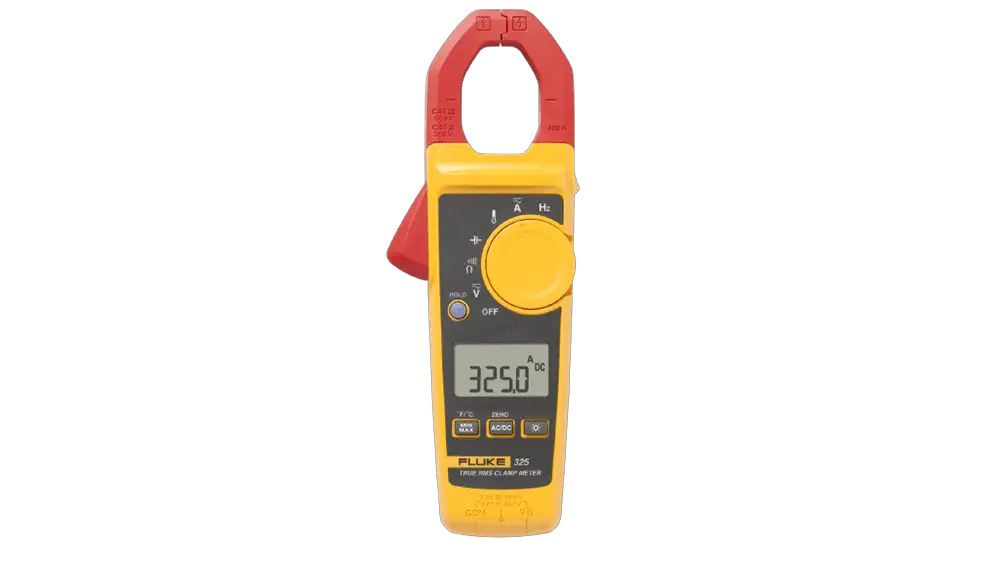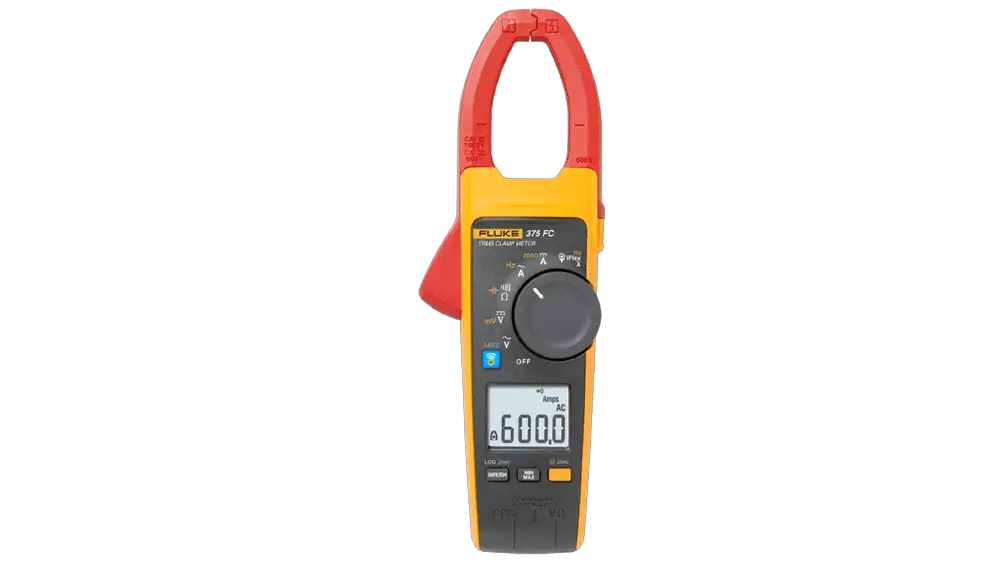Fluke 325 VS Fluke 375 Clamp Multimeter Comparison
A reliable multimeter is one of the most important tools you can have for industrial maintenance. After all, it’s important to be able to accurately measure different types of electrical signals to avoid problems and keep everything running smoothly. So, if you are looking for a new best multimeter, you might see the Fluke 325 and the Fluke 375.
Professionals like both of these models, but how do they compare to each other? Let’s look at the differences between the Fluke 325 and Fluke 375 to see which one might be better for you. One of the main ways that the Fluke 325 and 375 are different from each other is in their features.
The Fluke 325 is an easy-to-use model that works well for most tasks. The Fluke 375, on the other hand, is a better model for industrial use because it is more advanced and has more features.
Table of Contents
Comparison Fluke 325 VS 375 Multimeter:
| Features | Fluke 325 | Fluke 375 |
|---|---|---|
| Product Dimensions | 9.49 x 4.21 x 2.72 inches | 24 x 24 x 24 inches |
| Product Weight | 10.41 Ounces | 13.9 Ounces |
| Backlight | Yes | No |
| CAT rating | CAT IV 300V/CAT III 600 V | CAT III 1000V, CAT IV 600V |
| Data hold | Yes | No |
| Jaw Opening | 30 mm | 34 mm |
| Warranty | Two-years | Three-years |
| Frequency | 5 Hz to 500 Hz | 500 Hz5 Hz to 500 Hz |
| Temperature | -10 °C to 400 °C | 10°C – +50°C |
Fluke 325 vs. 375 Review
When choosing a multimeter, there are a lot of things to think about. But their performance may be the most important thing.
We chose to compare the Fluke 325 and 375 because of this. The Fluke 325 and 375 multimeters are the best choices if you need a tool that is accurate and works well. But which one is nearer the other?
Here’s a quick overview of the key differences between the two models:
The Fluke 325 has a large backlit display that makes it easy to read even in low light conditions. It also features True RMS technology for accurate measurements.
The Fluke 375, on the other hand, has a smaller display but comes with a built-in data logging function. This allows you to store up to 99 readings, which is handy if you need to track measurements over time.
So, which is the better multimeter? It really depends on your needs. If you need a large display and accurate measurements, then the Fluke 325 is a good choice. If you need to track measurements over time, then the Fluke 375 is a better option.
Fluke 325 Clamp Multimeter AC-DC TRMS:
The Fluke 325 is a true-RMS clamp meter that measures ac and dc voltage, resistance, continuity, frequency, and capacitance. It also measures temperature in both Celsius and Fahrenheit. The Fluke 325 has a large jaw opening that allows it to fit around bulky conductors. The backlight makes it easy to read the display in low-light conditions. The Auto V/LoZ function prevents false readings due to ghost voltages. The auto-hold function freezes the reading on the display so you can take your hands off of the meter without losing the reading.
The included test leads have alligator clips that make it easy to attach them to wires. The thin design of the clamp jaws allows the meter to fit into tight spaces. The included case protects the meter from drops and damage.
The Fluke 325 is a great choice for electricians, HVAC technicians, and general maintenance workers who need a reliable clamp meter that can measure a variety of different electrical parameters.
Key Features:
- True-RMS measurement for ac and dc voltage
- Measures resistance, continuity, frequency, and capacitance
- Measures temperature in Celsius and Fahrenheit
- Large jaw opening for bulky conductors
- Backlight for low-light conditions
- Auto V/LoZ function prevents false readings
- AutoHold function freezes reading on the display
- Alligator clip test leads included
- Thin design of clamp jaws for tight spaces
1. True RMS:
The true RMS function on the Fluke 325 accurately measures ac voltage and waveforms that are not perfectly sine waves. This is important for measuring devices that use switching power supplies, such as computers.
2. Auto V/LoZ:
The Auto V/LoZ function prevents false readings due to ghost voltages. This is useful for troubleshooting electrical systems.
3. AutoHold:
The auto-hold function freezes the reading on the display so you can take your hands off of the meter without losing the reading. This is useful when you need to take measurements in difficult or dangerous positions.
4. Alligator Clip Test Leads:
The included test leads have alligator clips that make it easy to attach them to wires. The alligator clips have a spring-loaded design that keeps them securely attached to the wires.
5. Thin Design of Clamp Jaws:
The thin design of the clamp jaws allows the meter to fit into tight spaces. This is useful for measuring wires in difficult-to-reach places.
6. Protective Case:
The included case protects the meter from drops and damage. The case has a belt loop that allows you to keep the meter within easy reach.
Pros:
- Best in its class for AC voltage and resistance
- True RMS for accurate measurements
- The large display is easy to read
- A built-in flashlight illuminates dark areas
Cons:
- A bit pricey for a basic multimeter.
- Some people find the buttons hard to press.
Fluke 375 FC True-RMS 600A AC/DC Wireless Clamp Meter
The Fluke 375 FC is an AC/DC clamp meter that can be used with the separate iFlex flexible current probe. With the free Fluke Connect app, you can take measurements and share the results with your team without having to go back to the office. The iFlex probe streams measurements wirelessly from hard-to-reach places to meters up to 20 feet (6 meters) away, so you don’t have to worry about getting tangled up in wires.
Even when there isn’t much light, the large backlit display makes it easy to read, and the LED work light lets you see what you’re doing. The 375 FC can measure from 0.1 A to 600 A AC/DC and can also measure temperature, voltage, resistance, and continuity. It also has a data hold feature that lets you freeze the reading on the screen for easy reference and a low-battery indicator that lets you know when it’s time to change the batteries. The two AA alkaline batteries that come with the clamp meter are used to power it. It also comes with a carrying case, an instruction manual, and information on how to use it safely.
Key Features:
- Use the iFlex wireless flexible current probe to measure true RMS AC/DC.
- Connect wirelessly with the free Fluke Connect app.
- The large backlit screen makes it easy to read when there isn’t much light.
- When you use the data hold function, the display stays at the same reading.
- A light that says “low battery” lets you know when it’s time to change the batteries.
- It works with two AA alkaline batteries (included).
- Three years of guarantee.
Display:
Backlit LCD for easy viewing even in low light conditions
Data logging:
capture up to 65,000 readings over extended periods of time
Auto-ranging:
automatically selects the correct range for the measurement being taken
Min/Max/Average:
captures changes over time to help identify irregularities
Inrush current:
measures the amount of current required to start large motors or other loads that draw high inrush currents
Auto power off:
This conserves battery power when the unit is not in use.
Battery life:
up to 2000 measurements with alkaline batteries
Safety rating:
CAT III 600V, CAT IV 300V
Pros:
- Fluke 375 is a very rugged and durable clamp meter, designed to withstand heavy use in harsh environments.
- It has a large jaw opening, making it easy to take measurements on large conductors.
- The Fluke 375 has a backlit display, making it easy to read in low-light conditions.
- Built-in flashlight, making it easier to take measurements in dark or confined spaces.
- Auto-power off feature, which conserves battery life when the clamp meter is not in use.
Cons:
- Fluke 375 is a bit expensive, compared to other clamp meters on the market.
- It is a bit large and bulky, making it difficult to carry in a pocket.
- The Fluke 375 does not have a built-in temperature measurement function.
Frequently Asked Questions
Most people believe that clamp meters are better than standard multimeters, but this is not always true. What you need to measure and how you intend to use the meter are the most important considerations.
A clamp meter can be useful when measuring AC voltage or current. This is because the jaws can hold a wire or conductor without disassembling it. If you want to measure something in an already running electrical system, this can be very useful. Because most clamp meters can handle more amperage than regular meters, they can be used in situations where regular meters would overflow.
Multimeters can measure voltage, current, and resistance in electronic circuits. Clamp meters, on the other hand, can only measure current. Clamp meters are more specialized tools that allow electricians to measure current quickly and easily without having to open up or disconnect wires. This can be very helpful when it would be hard or dangerous to get to the wires directly.
But in some ways, clamp meters aren’t as good as multimeters. For example, they can only measure AC current. They can’t measure resistance or voltage. Overall, clamp meters are a useful tool for electricians, but they are not always better than multimeters. It depends on what’s going on.
When selecting a Fluke clamp meter, there are a few factors to consider. First, you must determine how precise you must be. Second, determine what is most important to you. Third, ensure that the clamp meter can be used for the purposes you intend.
Accuracy is important because it helps you take accurate measurements If you don’t need measurements that are very accurate, you can save money by going with a less expensive model. But if your work depends on accuracy, you’ll need to spend more on a high-end model. What you want the clamp meter to do will determine what features you need. For example, if you need to measure AC current, you’ll need a model that has a range for AC current. There are also a backlit display, auto-ranging, and data hold to look for.
Lastly, make sure the clamp meter you choose will work with the devices you want to use it with. Read the specs carefully before you buy, because some models only work with certain kinds of devices. If you think about these things, you should be able to find the best Fluke clamp meter for your needs.
Conclusion:
The FLUKE 325 and FLUKE 375 are two of the tools that electricians use most often. The Fluke 325 is great for beginners, but the FLUKE 375 does a better job.
Simple things that the FLUKE 325 can do include testing circuits and reading test codes. On the other hand, the FLUKE 375 is great at more difficult tasks like finding and fixing broken circuits. Overall, electricians who have used tools before will be better off with the FLUKE 375.







